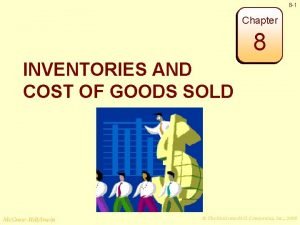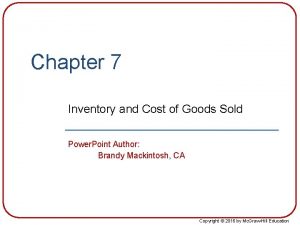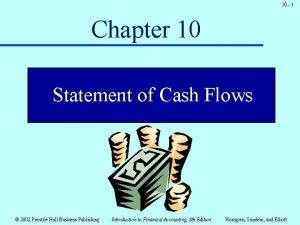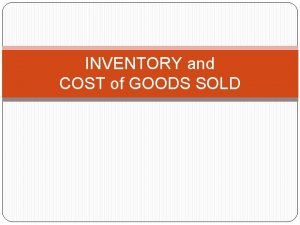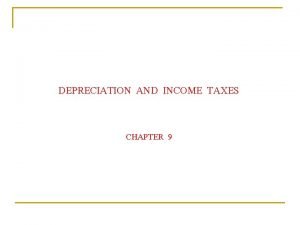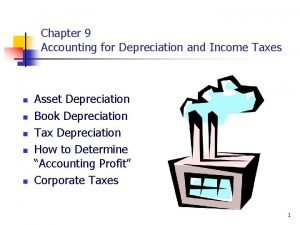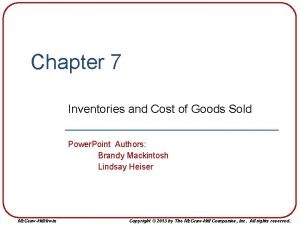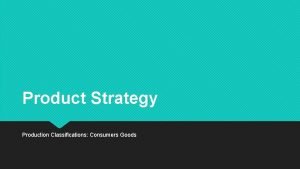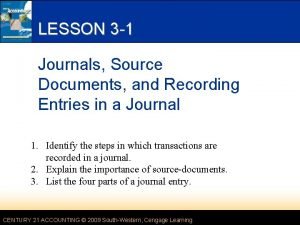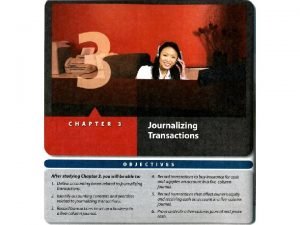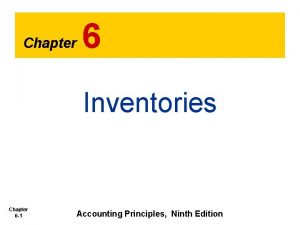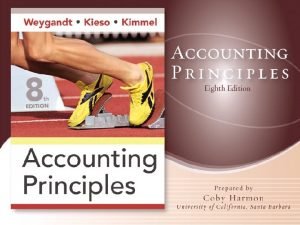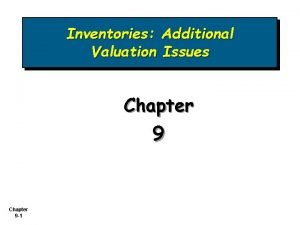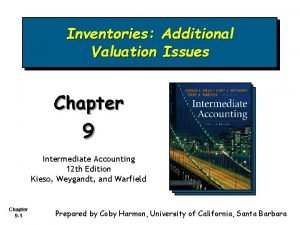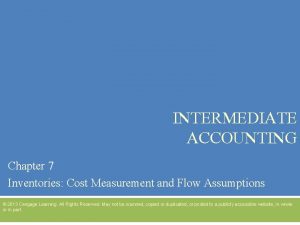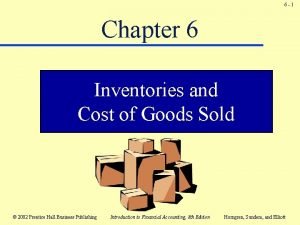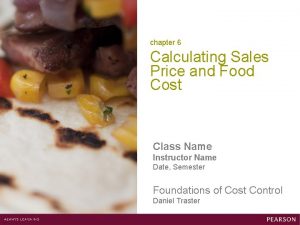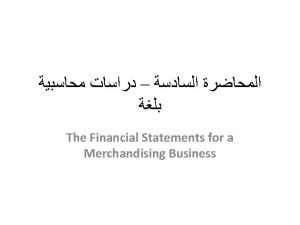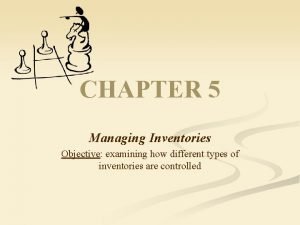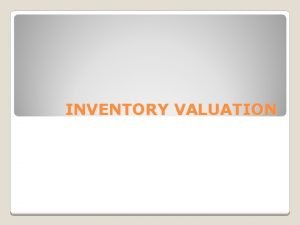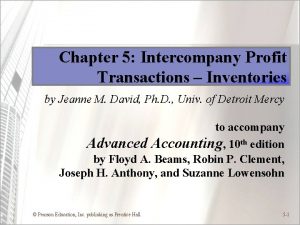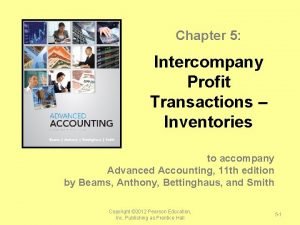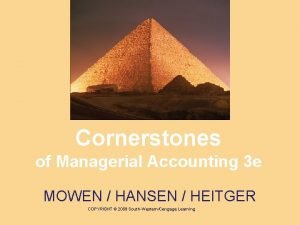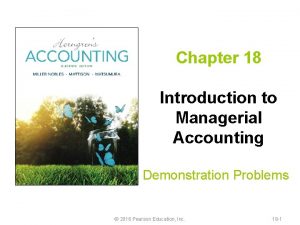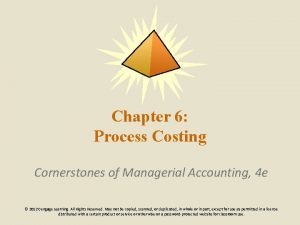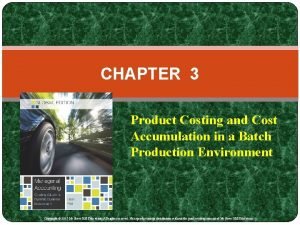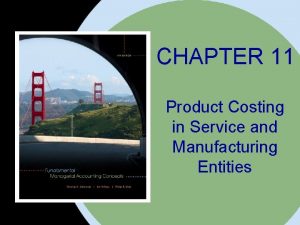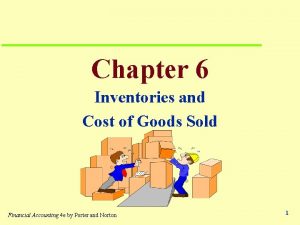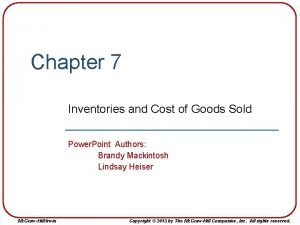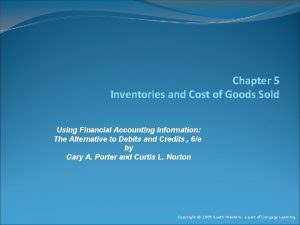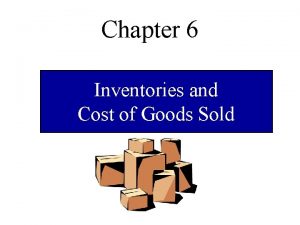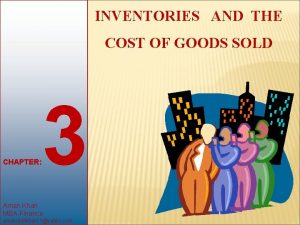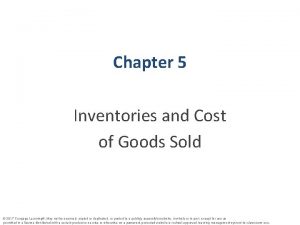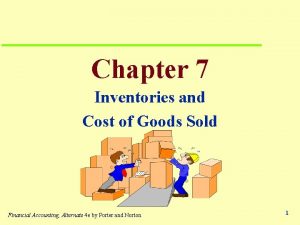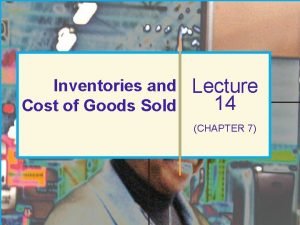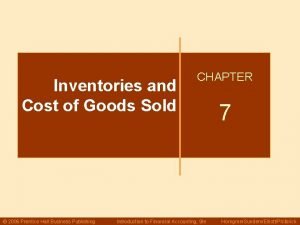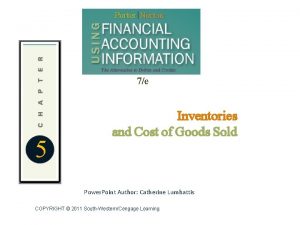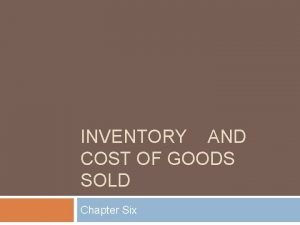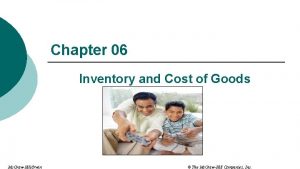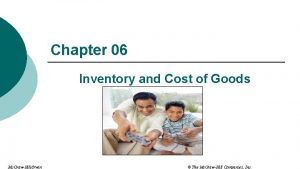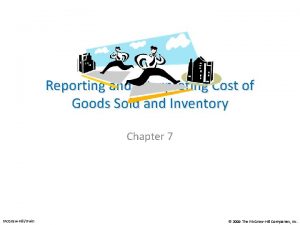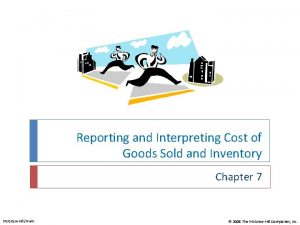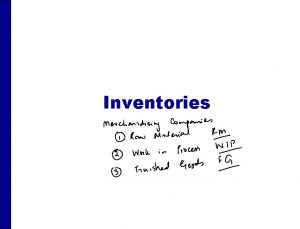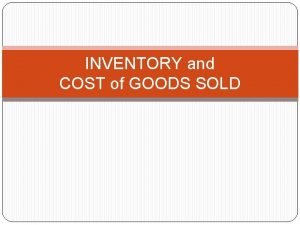Inventories and the Cost of Goods Sold Chapter







































- Slides: 39

Inventories and the Cost of Goods Sold Chapter 8 Mc. Graw-Hill/Irwin Copyright © 2010 by The Mc. Graw-Hill Companies, Inc. All

The Flow of Inventory Costs BALANCE SHEET Purchase costs (or manufacturing costs) Asset Inventory INCOME STATEMENT as goods are sold Revenue Cost of goods sold Gross profit Expenses Profit 8 -2

The Flow of Inventory Costs In a perpetual inventory system, inventory entries parallel the flow of costs. 8 -3

Which Unit Did We Sell? When identical units of inventory have different unit costs, a question naturally arises as to which of these costs should be used in recording a sale of inventory. 8 -4

Inventory Subsidiary Ledger A separate subsidiary account is maintained for each item in inventory. How can we determine the unit cost for the 10 Sept. sale? 8 -5

Data for an Illustration The Bike Company (TBC) 8 -6

Specific Cost Identification On 14 August, TBC sold 20 bikes for $130 each. Of the bikes sold 9 originally cost $91 and 11 cost $106. The Cost of Goods Sold for the 14 August sale is $1, 985. This leaves 5 units, with a total cost of $515, in inventory: 1 unit that costs $91 and 4 units that cost $106 each. 8 -7

Specific Cost Identification Retail (20 × $130) Cost A similar entry is made after each sale. 8 -8

Specific Cost Identification Additional purchases were made on 17 and 28 August. 8 -9

Specific Cost Identification Income Statement COGS = $4, 595 Balance Sheet Inventory = $1, 395 8 -10

Weighted Average Cost Method On 14 August, TBC sold 20 bikes for $130 each. The weighted average cost per unit must be computed prior to each sale. $2, 500 25 = $100 avg. cost 8 -11

Weighted Average Cost Method Additional purchases were made on 17 August and 28 August. On 31 August, an additional 23 units were sold. $114 = $3, 990 35 8 -12

Weighted Average Cost Method Income Statement COGS = $4, 622 Balance Sheet Inventory = $1, 368 8 -13

First-In, First-Out Method (FIFO) On 14 August, TBC sold 20 bikes for $130 each. The Cost of Goods Sold for the 14 August sale is $1, 970, leaving 5 units, with a total cost of $530, in inventory. 8 -14

First-In, First-Out Method (FIFO) Additional purchases were made on 17 Aug. and 28 Aug. On 31 August, an additional 23 units were sold. 8 -15

First-In, First-Out Method (FIFO) Income Statement COGS = $4, 570 Balance Sheet Inventory = $1, 420 8 -16

8 -17

The Principle of Consistency Once a company has adopted a particular accounting method, it should follow that method consistently rather than switch methods from one year to the next. 8 -18

Taking a Physical Inventory The primary reason for taking a physical inventory is to adjust the perpetual inventory records for unrecorded shrinkage losses, such as theft, spoilage, or breakage. 8 -19

LCNRV and Other Write. Downs of Inventory Obsolescence Lower of Cost and Net Realizable Value (LCNRV) Reduces the value of the inventory. Adjust inventory value to the lower of historical cost or net realizable value (NRV). 8 -20

LCNRV and Other Write. Downs of Inventory 8 -21

Goods In Transit A sale should be recorded when title to the goods passes to the buyer. F. O. B. shipping point title passes to buyer at the point of shipment. Year End F. O. B. destination point title passes to buyer at the point of destination. 8 -22

Periodic Inventory Systems In a periodic inventory system, inventory entries are as follows. Note that an entry is not made to inventory. 8 -23

Periodic Inventory Systems In a periodic inventory system, inventory entries are as follows. 8 -24

Information for the Following Inventory Examples 8 -25

C o s t Specific Cost Identification o f G o o d s S o l d $ 9 , 7 2 5 8 -26

Weighted Average Cost Method WAC $9, 725 1, 800 = $5. 40278 Ending Inventory WAC $5. 40278 1, 200 = $6, 483 Cost of Goods Sold WAC $5. 40278 600 = $3, 242 8 -27

First-In, First-Out Method (FIFO) Remember: Start with the 29 Nov purchase and then add other purchases until you reach the number of units in ending inventory. 8 -28

First-In, First-Out Method (FIFO) Now, we have allocated the cost to all 1, 200 units in ending Now, let’s inventory. complete the table. 8 -29

First-In, First-Out Method (FIFO) Completing the table summarizes the computations just made. 8 -30

Importance of an Accurate Valuation of Inventory An error in ending inventory in a year will result in the same error in the beginning inventory of the next year. 8 -31

The Gross Profit Method 1. Determine cost of goods available for sale. 2. Estimate cost of goods sold by multiplying the net sales by the cost ratio. 3. Deduct cost of goods sold from cost of goods available for sale to determine ending inventory. 8 -32

The Gross Profit Method In March 2010, Matrix Company’s inventory was destroyed by fire. Matrix normal gross profit ratio is 30% of net sales. At the time of the fire, Matrix showed the following balances: 8 -33

The Gross Profit Method × 7 0 % Step 1 Step 2 Step 3 8 -34

The Retail Method The retail method of estimating inventory requires that management determine the value of ending inventory at retail prices. In March of 2009, Matrix Company’s inventory was destroyed by fire. At the time of the fire, Matrix’s management collected the following information: 8 -35

The Retail Method Matrix would follow the steps below to estimate their ending inventory using the retail method. 8 -36

Financial Analysis (Beginning Inventory + Ending Inventory) ÷ 2 8 -37

Financial Analysis (Beginning Receivables + Ending Receivables) ÷ 2 8 -38

End of Chapter 8 8 -39
 Chapter 8 inventories and the cost of goods sold
Chapter 8 inventories and the cost of goods sold Record cost of goods sold
Record cost of goods sold Cash flow statement
Cash flow statement Cost of goods sold formula carriage inwards
Cost of goods sold formula carriage inwards Cost of goods sold depreciation
Cost of goods sold depreciation Cost of goods sold depreciation
Cost of goods sold depreciation Cost of goods sold formula
Cost of goods sold formula Consumer products classifications
Consumer products classifications Dr. krishna's learning centre
Dr. krishna's learning centre A form for recording transactions in chronological order
A form for recording transactions in chronological order Information for each transaction recorded in a journal.
Information for each transaction recorded in a journal. Chapter 6 inventories
Chapter 6 inventories Inventory accounting principles
Inventory accounting principles Chapter 9 inventories additional valuation issues
Chapter 9 inventories additional valuation issues Lower of cost or market
Lower of cost or market Inventory intermediate accounting
Inventory intermediate accounting Chapter 6 inventories
Chapter 6 inventories Cost of food sold formula
Cost of food sold formula Purchase discount in accounting
Purchase discount in accounting Progressive tax examples
Progressive tax examples Merit good vs public good
Merit good vs public good Public goods dan private goods adalah
Public goods dan private goods adalah Financial statements of a merchandising business
Financial statements of a merchandising business Informal assessments
Informal assessments Non recycled inventory examples
Non recycled inventory examples Wac inventory
Wac inventory Juloidian inventories
Juloidian inventories Golf inventory analysis
Golf inventory analysis Intercompany inventory transactions
Intercompany inventory transactions Intercompany journal entries
Intercompany journal entries Smarter inventories
Smarter inventories Financial and managerial accounting weygandt kimmel kieso
Financial and managerial accounting weygandt kimmel kieso How to calculate cost of goods transferred out
How to calculate cost of goods transferred out Cost of goods manufactured formula
Cost of goods manufactured formula Process costing problems and solutions doc
Process costing problems and solutions doc Manufacturing overhead cost
Manufacturing overhead cost Underapplied overhead
Underapplied overhead Cost accumulation and cost assignment
Cost accumulation and cost assignment Cost accumulation and cost assignment
Cost accumulation and cost assignment Cost accumulation and cost assignment
Cost accumulation and cost assignment
